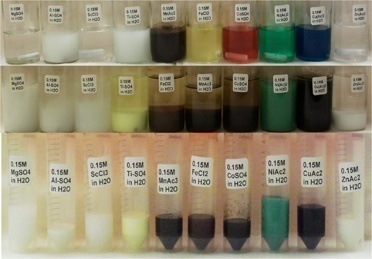Synthesizing Nanoparticles from Simple Salt Solutions in Water
Author: Naval Research Laboratory
Published: 2014/09/24 - Updated: 2021/11/06
Category Topic: Nanomedicine and Nanotechnology - Academic Publications
Page Content: Synopsis - Introduction - Main
Synopsis: One-step process uses potassium superoxide (KO2) to rapidly form oxide nanoparticles from simple salt solutions in water. Typically, the synthesis of oxide nanoparticles involves the slow reaction of a weak oxidizing agent, such as hydrogen peroxide, with dilute solutions of metal salts or complexes in both aqueous and non-aqueous solvent systems.
Introduction
Scientists at the U.S. Naval Research Laboratory (NRL) Materials Science and Technology Division have developed a novel one-step process using, for the first time in these types of syntheses, potassium superoxide (KO2) to rapidly form oxide nanoparticles from simple salt solutions in water.
Main Content
The U.S. Naval Research Laboratory is the Navy's full-spectrum corporate laboratory, conducting a broadly based multidisciplinary program of scientific research and advanced technological development. The Laboratory, with a total complement of approximately 2,500 personnel, is located in southwest Washington, D.C., with other major sites at the Stennis Space Center, Miss., and Monterey, Calif. NRL has served the Navy and the nation for over 90 years and continues to meet the complex technological challenges of today's world.
"Typically, the synthesis of oxide nanoparticles involves the slow reaction of a weak oxidizing agent, such as hydrogen peroxide, with dilute solutions of metal salts or complexes in both aqueous and non-aqueous solvent systems," said Dr. Thomas Sutto, NRL research chemist. "The rapid exothermic reaction of potassium superoxide with the salt solutions results in the formation of insoluble oxide or hydroxide nano-particulates."
An important advantage of this method is the capability of creating bulk quantities of materials. NRL has demonstrated that large quantities (over 10 grams) of oxide nanoparticles can be prepared in a single step, which is approximately four orders of magnitude higher yield than many other methods. The metal concentrations, usually in the millimolar (mM) amount, need to be low in order to prevent aggregation of the nanoparticles into larger clusters that could significantly limit the amount of material that can be prepared at any one time.

Oxide nanoparticles have been shown to be crucial components in numerous applications to include electronic and magnetic devices, energy storage and generation, and medical applications such as magnetic nanoparticles for use in magnetic resonance imaging (MRI). In all of these applications, particle size is critical to the utility and function of oxide nanoparticles - decreased particles size results in increased surface area, which can significantly improve the performance of the oxide nanoparticle.
In order to demonstrate the broad scale applicability of this new method, oxide or hydroxide nanoparticles have been prepared from representative elements from across the periodic table to rapidly produce nanometer sized oxides or hydroxides. In addition to the elements converted to oxide nanoparticles in the above illustration, it has also been shown that oxide nanoparticles can be prepared from second and third row transition metals, and even semi-metals such as tin, bismuth, thallium and lead.
One exciting aspect of this technique is that it can also be used to produce blends of nanoparticles. This has been demonstrated by preparing more complex materials, such as lithium cobalt oxide - a cathode material for lithium batteries; bismuth manganese oxide - a multiferroic material; and a 90 degrees Kelvin (K) superconducting Yttrium barium copper oxide material. As such, this new synthetic route to oxide nanoparticles also shows great promise for a multitude of other catalytic, electrical, magnetic, or electrochemical processes, from novel cathodes to solution preparation of other types of ceramic materials.
Attribution/Source(s): This quality-reviewed publication was selected for publishing by the editors of Disabled World (DW) due to its relevance to the disability community. Originally authored by Naval Research Laboratory and published on 2014/09/24, this content may have been edited for style, clarity, or brevity.